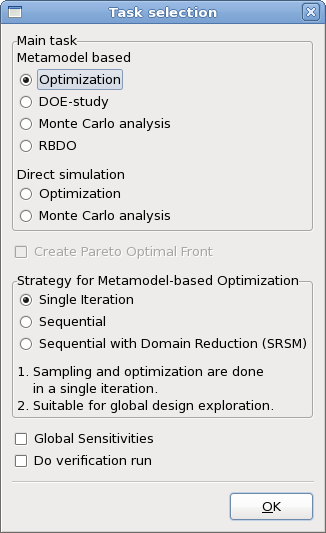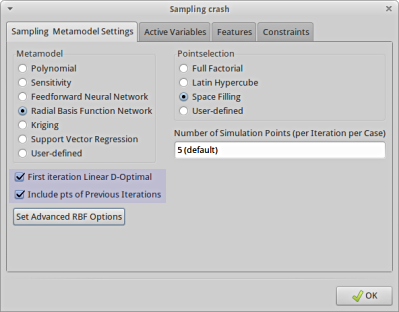
In this approach, the experimental design for choosing the sampling points is done only once. A typical application would be to choose a large number of points (as much as can be afforded) to build metamodels such as, RBF networks using the Space Filling sampling method. This is probably the best way of sampling for Space Filling since the Space Filling algorithm positions all the points in a single cycle.
The following options should default to the settings indicated:
The GUI settings are also explained in Figure 20.1.
Figure 20.1 Required settings in Sampling panel for Single Stage strategy
In this approach, sampling is done sequentially. A small number of points is chosen for each iteration and multiple iterations are requested. The approach has the advantage that the iterative process can be stopped as soon as the metamodels or optimum points have sufficient accuracy. It was demonstrated that, for Space Filling, the Sequential approach had similar accuracy compared to the Single Stage approach,i.e. 10 × 30 points added sequentially is almost as good as 300 points. Therefore both the Single Stage and Sequential Methods are good for design exploration using a surrogate model. For instance when constructing a Pareto Optimal Front, the use of a Single Stage or Sequential strategy is recommended in lieu of a Sequential strategy with domain reduction (see Sequential strategy with domain reduction).
Both the previous strategies work better with metamodels other than polynomials because of the flexibility of metamodels such as neural networks to adjust to an arbitrary number of points.
The following options should default to the settings indicated:
The GUI settings are also explained in Figure 20.2.

Figure 20.2 Required settings in Sampling panel (left) and Run panel (right) for sequential strategy without domain reduction
This approach is the same as the Sequential strategy but in each iteration the domain reduction strategy is used to reduce the size of the subregion. During a particular iteration, the subregion is used to bound the positions of new points. This method is typically the only one suitable for polynomials. There are two approaches to Sequential Domain Reduction strategies. The first is global and the second, local.
As for the Sequential strategy without domain reduction, sequential adaptive sampling is done and the metamodel constructed using all available points, including those belonging to previous iterations. The difference is that in this case, the size of the subregion is adjusted (usually reduced) for each iteration. This method is good for converging to an optimum and moderately good for constructing global approximations for design exploration such as a Pareto Optimal front. The user should however expect to have poorer metamodel accuracy at design locations remote from the current optimum.
The following options should default to the settings indicated:
In the GUI, the sampling panel setting is the same as in Figure 20-2 (left).
SRSM is the original LS-OPT automation strategy and allows the building of a new response surface (typically linear polynomial) in each iteration. The size of the subregion is adjusted for each iteration. Points belonging to previous iterations are ignored. This method is only suitable for convergence to an optimum and should not be used to construct a Pareto optimal front or do any other type of design exploration. Therefore the method is ideal for system identification.
The following options should default to the settings indicated: